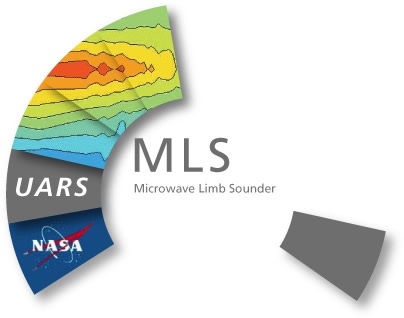
MLS

The EOS Microwave Limb Sounder (MLS) has been flown on the Aura Spacecraft (15 July 2004) along with the Ozone Monitoring Instrument (OMI), High Resolution Dynamics Limb Sounder and Tropospheric Emission Spectrometer. The Aura MLS is an improved version of the UARS MLS instrument, with better spatial resolution and coverage, extended vertical range, and capability of measuring some new chemical constituents never measured before globally from space. MLS will continue the very valuable long-term record of atmospheric compositions measurements made by the UARS sensors.
Since launch, MLS has been providing simultaneous global measurement of vertical profiles of several atmospheric chemical constituents (O3, HCl, ClO, HOCl, BrO, OH, H2O, HO2, HNO3, N2O, CO, HCN, volcanic SO2), cloud ice, geopotential height, and temperature of the atmosphere for the understanding of atmospheric chemical processes, ozone depletion, and how atmospheric constituents affect air quality and the climate. MLS measurements of upper tropospheric water vapor, ice content, ozone, CO, and N2O will be used for studying their effects on radiative forcing of climate change and for the understanding of troposphere-stratosphere exchange. These measurements will also be valuable for the air quality models in quantifying the role of the upper tropospheric pollutants.
| O3 and HNO3volume mixing ratio | |

|

|
| Description: Daily gridded O3 and HNO3volume mixing ratio | |
| Projection: Global / Northern Hemisphere / Southern Hemisphere / | |
| Image Archive | |
| Data Archive | |
Objectives
MLS will measure important ozone-destroying chemical species in the upper troposphere and stratosphere to improve understanding and assessment of:
- Ozone Depletion
- emphasis on the lower stratosphere, but perform critical monitoring of the entire stratosphere during the period when ozone is most vulnerable to destruction by chlorine - Climate Change
- emphasis on processes in the upper troposphere and lower stratosphere for both seasonal-to-interannual and long-term climate variability - Tropospheric Ozone
- distribution of upper tropospheric ozone measured directly
- distribution of total tropospheric ozone from TOMS-MLS, OMI-MLS - Volcanic Effects
- on ozone depletion and climate change
Instrument
Onboard MLS has five radiometers at sub-millimeter and millimeter frequencies to measure upper-tropospheric / lower stratospheric processes. MLS radiometers provide new meteorological information such as height-resolved cloud ice water content (IWC).
| Instrument Type | Passive microwave limb-sounding radiometer/spectrometer Measures thermal emission from the atmospheric limb |
| Heritage | Upper Atmosphere Research Sattelite (UARS) Microwave Limb Sounder |
| Spectral Bands | At millimeter and submillimeter wavelengths |
| Spectral Sampling | Measurements are performed along the sub-orbital track, and resolution varies for different parameters; 5 km cross-track x 500 km along-track x 3 km vertical are typical values. |
| Channels | 5 channels (118, 190, 240, 640 GHz and 2.5 THz). |
| Swath Width | 1.5 km vertical x 3 km cross-track x 300 km along-track at the limb tangent point for 640 GHz and higher frequencies. |
Data Access
General Data Product Level Definition
MLS v1.5 data are available from the NASA Goddard Space Flight Center Earth Sciences (GES) Distributed Active Archive Center (DAAC).
The UARS and Aura Platform
UARS was launched in 1991 by the Space Shuttle Discovery and carries 10 instruments. The satellite orbits at an altitude of 375 miles with an orbital inclination of 57 degrees. Designed to operate for three years, six of its ten instruments are still functioning. UARS measures ozone and chemical compounds found in the ozone layer which affect ozone chemistry and processes. UARS also measures winds and temperatures in the stratosphere as well as the energy input from the Sun. Together, these help define the role of the upper atmosphere in climate and climate variability.
UARS carries 10 instruments: ACRIM (Active Cavity Radiometer Irradiance Monitor), CLAES, HALOE, HRDI (High Resolution Doppler Imager), ISAMA, MLS, PEM (Particle Environment Monitor), SOLSTICE (SOLar STellar Irradiance Comparison Experiment), SUSIM (Solar Ultraviolet Spectral Irradiance Monitor) and WIND II.
UARS was officially decommissioned on Dec14, 2005.
The Aura spacecraft was successfully launched on July 15, 2004 aboard a Delta II 7920-10L, a two stage expendable rocket, from the Vandenberg Western Test Range. The mission hosts a suite of scientific instruments designed to make the most comprehensive measurements ever undertaken of trace gases in the environment that surrounds earth. The satellite's orbit will allow measurements to be taken at all latitudes; instruments will make continuous scans at altitudes ranging from the stratosphere down through the troposphere. EOS Aura is the third in a series of major Earth observing satellites to study the environment and climate change and is part of NASA's Earth Science Enterprise. The first and second missions, Terra and Aqua, are designed to study the land, oceans, and the Earth's radiation budget.
The satellite carries four state-of-the-art instruments:
- High Resolution Dynamics Limb Sounder (HIRDLS)
- Microwave Limb Sounder (MLS)
- Ozone Monitoring Instrument (OMI)
- Tropospheric Emission Spectrometer (TES)
Links
Contact
If you would like to have more information about the MLS data, please contact wdc@dlr.de.